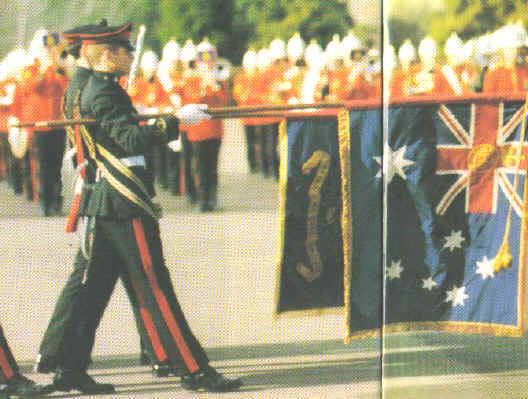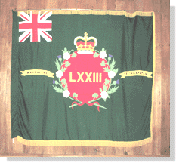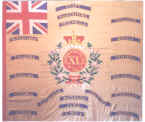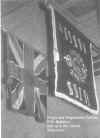 |
|
|||
| In earlier days the colours were trooped through the ranks prior to an engagement so that they could be recognised by all ranks as a rallying point during the battle. To-day the Trooping of the Colours through the ranks of the Regiment is continued as a Ceremonial Movement only. The photo below (I apologise for the quality) shows The Colours of Royal Military College Duntroon being trooped at a Marching Out (Graduation) Parade. |
|
|
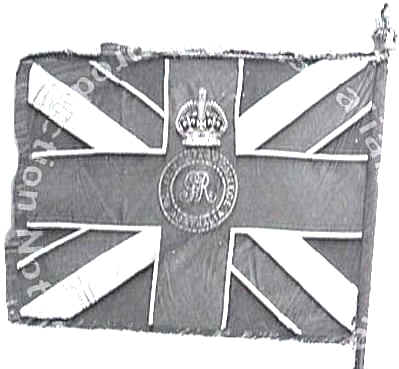 |
The King's Colours of
the Royal Military College at Duntroon House, Duntroon ACT.
This was the original King's Colour presented to RMC. |
|
Before being presented, the Colours are always consecrated at a religious ceremony on parade where Godís blessing on them is asked. This dates back to the Battle of the Standard in 1138 when the Yeoman of Yorkshire took with them consecrated banners from York Cathedral, and fought so fiercely to save the banners that they defeated heavy odds. |
| The earliest serving unit in Australia for which I can find Colours is the 73rd Regiment of Foot, the Royal Highlanders. |
|
Replica Size Width: 188 cm (74") Height: 165 cm (65") |
In
1809 Lachlan Macquarie was Colonel of the 73rd Regiment when he was
appointed Governor of New South Wales. In 1807 the 73rd had received new
colours and accoutrements from Lieut-General George Harris. These were
the colours taken to New South Wales and of which no trace now remains.
This replica hangs on the walls of the Lachlan Macquarie Room, and represents the regimental colours and accoutrements as they would have been in 1807, and includes the battle honours won by the 73rd Regiment in India at Mangalore (1783-84): |
|
The 42nd Battalion of the Royal Highlanders |
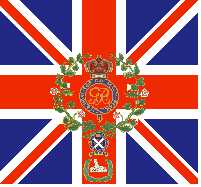 |
The King's Colour was the Great Union flag or Union Jack. In the centre of the flag was a crowned garter. Inside the Garter, the Royal Cypher, "GR" interlaced, on red. The Garter was surrounded by the Union Wreath (rose, thistle and shamrock) and at the junction of the sprays was the badge of St. Andrew. The Sphinx on a tablet lettered "EGYPT" was under the Garter and Wreath. A scroll lettered "PENINSULAR" was placed over the crown, it is thought this was added after 1815. This Battalion served in Australia |
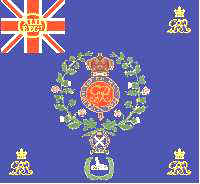 |
The Regimental Colour was a dark blue with the same device in the centre. In the upper canton next to the pike or staff was the Union Flag (Union Jack). In the centre of the union flag, within an oval device, was the regimental number stated in roman numerals. In the other three corners the Royal Cipher interlaced and reversed. Please note that this Colour is NOT a variation of the Australian Blue Ensign. |
| In
both cases the flag was six feet six inches (1.9m) flying and six
feet (1.82m) down the staff. The length of the staff, spear point and
ferrule combined was nine feet ten inches (2.9m).The colours marched
together and each was carried by an Ensign (a subaltern officer). In
action, the colour would be largely wound around the staff with only
part of it flying. |
|
| The (replica) Colours of the 40th Regiment of Foot who served in Australia from 1824 to 1829 and again 1854 to 1861. The battalion that served was the 2nd Somersetshire. | |
| The Australian system for infantry colors is very similar to the British system, consisting of a Queen's (national) colour and a Regimental Colour, but due to the longevity of Colours, many battalions still carry the Union Jack for a Queen's Colour. Regimental Colours follow the same rules as the British, with a wreath of wattle leaves substituting for the Union Wreath (roses, thistles and shamrocks). The Queen's Colour in the form of the Australian National Flag also closely follows the British system while accommodating a different flag design. |
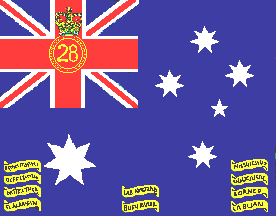 |
The example is
the 28th Battalion of The Royal Western Australia Regiment. Since 1960
the Reserves consist of one infantry regiment in each State, with a
varying number of battalions.
The battalions perpetuate old numbered battalions which fought in two world wars. The Queen's Colour uses the Union Jack in the canton as an almost identical replica of the British Queen's Colour. |
|
A gold-edged circle fills the center of the St. George Cross. Inside the circle is the regiment's name. Enclosed in the circle is the battalion number. Normally the battalion number is in Roman numerals, but XXVIII would not fit aesthetically so it is rendered in Arabic numerals. The Regimental Colour, on the other hand, has the Roman numeral in the canton. The circle is surmounted by a Crown. The Regimental Colour contains eleven battle honour scrolls (South Africa, and ten selected honours from WWI). The Queen's Colour contains ten selected battle honour scrolls from WWII. These are arranged at the bottom of the flag where they interfere the least with the stars and balance the Union Jack in the canton. T.F. Mills, 24 April 1999 Editors note. Mr Mills is correct but the illustration can be a little confusing unless you read ALL the text. Battle Honours are normally emblazoned on the Regimental Colour. Having them emblazoned on the Sovereign's Colour is a special honour usually reserved for units of long standing or of great deeds. For an up to date example look at the 1RAR Queen's and Regimentals on The Colours |
|
